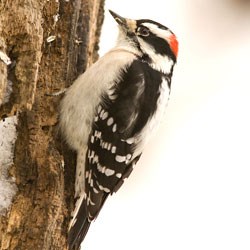
IntroductionDowny woodpeckers are a common backyard bird that readily comes to birdfeeders containing sunflower seeds or suet. Natural foods are primarily insects found on surfaces, crevices, and beneath the bark of trees. The downy woodpecker exploits food resources that most other birds cannot reach. Woodpeckers are ideally suited to this life of creeping up trees looking for insects. The downy's feet have two toes pointing forward and two backwards to provide a strong grasp on the bark of trees, although they can rotate one toe on each foot to the side for an even better grip. The entire tail braces the bird when it is excavating wood. The center two feathers on the downy's tail are stiffened by ribs that run their length and provide extra support. These two feathers are so important to the bird's way of life that they are molted only after all the other tail feathers are molted and regrown so the bird retains the bracing effects of the tail year round. The bill is very straight, to prevent the tip from breaking when hitting a hard surface. It is also chisel-shaped as a pointed bill would tend to bind in wood. The nares (nostrils) are protected from flying wood chips by a thin layer of stiff feathers and the bird protects its eyes by blinking as the bill strikes the wood. The tongue is also specialized as it is extremely long, barbed, and sticky allowing the downy to reach into the tunnels formed by larvae of wood-boring insects. Lastly, the frontal skull bones are folded at the base of the bill to act as shock absorbers and muscles behind the bill also help dampen the shock of the bill striking hard surfaces. Fascinating Facts
Identification
| |
Last updated: October 1, 2021
